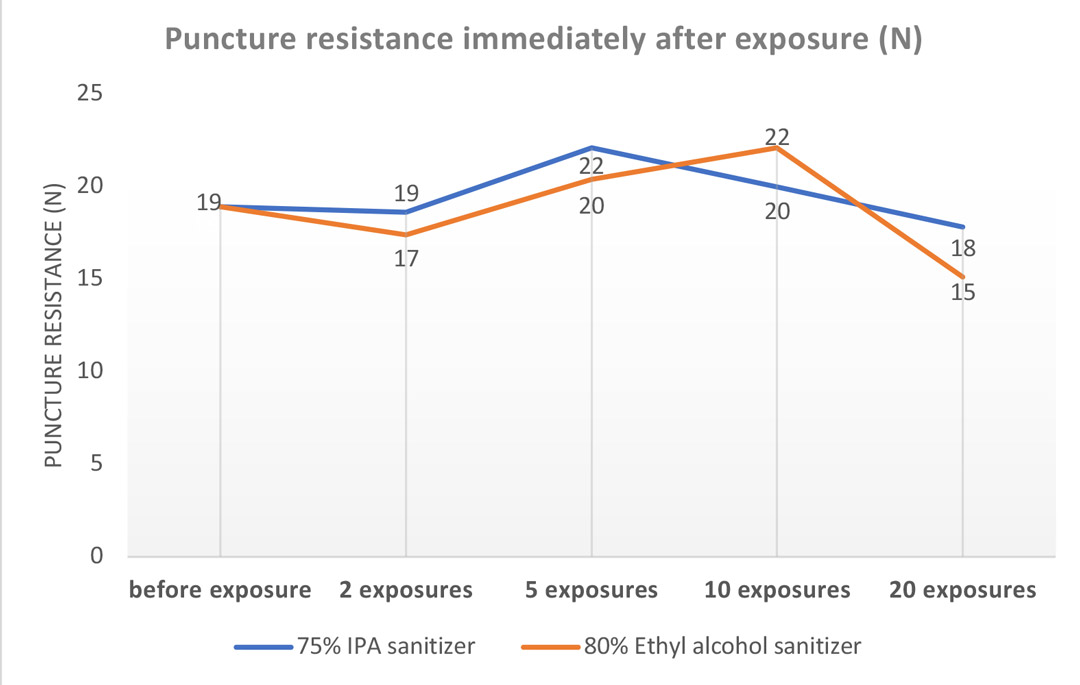| Subject: | Impact of Repetitive Exposure of SW® Single-Use Nitrile Gloves to Alcohol-Based Hand Sanitizers (ABHS) |
| Author: | Sisitha Sudarshana | Director of Technology, SW® |
Summary: The impact of repeated exposure of single use nitrile gloves (5 mil) to two types of commonly used alcohol-based hand sanitizers (ABHS) were evaluated. It was observed that intermittent repetitive exposure to ABHS did not have any significant impact on the integrity of the nitrile gloves even after 20 exposures within two hours based on the puncture resistance measured before and after exposures to the two types of ABHS.
Introduction: In the context of COVID-19 epidemic, there is a need for frequent sanitization of hands, especially for the medical staff who are handling patients as well as all the people who are in service industry in general. Since the wearing of hand protection has become an inevitable requirement for self-protection and the availability of gloves itself is becoming scarce, users cannot afford to change gloves after each patient examination. Thus, as advised by WHO, the frequent use of hand sanitizers on the gloved hands is a must to prevent any potential risk of cross-contamination with the COVID-19 virus that is highly contagious.
Therefore, there is a growing concern on the impact of the frequent use of alcohol-based hand sanitizers on the integrity of the thin nitrile gloves and the protection offered by them.
Objective: To determine the percentage reduction in physical performance and integrity of the gloves measured in terms of puncture resistance upon multiple exposures to ABHS.
Method:
-
- Take a 5mil single use nitrile glove (Powerform® S6)
- Make the puncture resistance measurements using EN 388 probe (control)
- Wear a pair of same nitrile gloves as above.
- Apply 70% IPA sanitizer on to the palm area of the glove and rub gently to spread all over for 15 seconds (as you would do for your bare hands – palm need to be covered)
- After 5 minutes, repeat above step 4.
- Make puncture resistance measurements immediately after the exposure for both gloves (worn in either hand)
- Take another pair of gloves each
- Perform step 4 and 5 repeatedly and make measurements at the below intervals
- After 2 applications of 75% IPA sanitizer (already done above)
- After 5 applications of 75% IPA sanitizer
- After 10 applications of 75% IPA sanitizer
- After 20 applications of 75% IPA sanitizer
Notes:
-
- Only one pair of gloves per one setting above
- Repeat the above steps (3-8) and make same measurements for the 80% ethyl alcohol-based hand sanitizer
Results:
- The behavior in puncture resistance against the number of repetitive exposures (up to 20 exposures) are given in chart below.

Figure 1: Change in puncture resistance before and after repetitive exposures to ABHS - There was no swelling of the glove material observed after 20 repetitive exposures to the ABHS.
- The percentage retention of puncture resistance after 20 repetitive exposures to the 75% IPA based hand sanitizer and 80% Ethyl alcohol-based sanitizer was 96% and 80% respectively; in comparison to the initial puncture resistance (before exposures).
Conclusion: Based on the above results, we can conclude that there is no significant reduction in the physical properties of single use nitrile gloves due to repetitive exposures to the two types of ABHS. After 20 such repetitive exposures, the retention of properties measured were more than 80%. There is no physical change in the glove material due to (20) repetitive exposures to ABHS.
Therefore, single use nitrile gloves can be recommended for frequent and repetitive hand sanitization using alcohol-based hand sanitizers/rubs.
Download the Hand Sanitizer and Nitrile Gloves Technical Report HERE.

